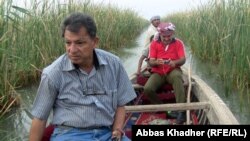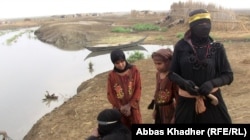When Saddam Hussein's regime collapsed, it appeared Iraq's once-abundant marshlands had been destroyed forever.
The former president had transformed the largest wetland ecosystem in Southwest Asia into desert in retaliation for a Shi'ite uprising in the early 1990s.
As a result, a 20,000-square-kilometer sanctuary for fish, migratory birds, and water buffalo was feared lost, along with the traditional way of life carried out for centuries by the inhabitants of the marshes, located between the Euphrates and Tigris rivers in southern Iraq.
By the time Hussein was toppled in 2003, some 90 percent of Iraq's marshland had been drained. Leading experts provided a dire assessment, predicting that the marshes could never be restored.
But local residents soon tore breaches in the earth dykes that Hussein had constructed, allowing water from the north to flow into the area again.
Within six months, the reed forests began to return. Broader efforts to restore and monitor the marshes followed. As a result, according to the United Nations, more than 40 percent of southern Iraq's marshes have been regenerated.
The return of wildlife highlights the positives, but questions remain about whether the lives of the marshland people can be fully restored.
'Accustomed To The City'
Hasan Ali was raised as a fisherman in Chibayish, where he lived with his parents in a traditional arched house made from marsh reeds and kept alive a centuries-old way of life.
In the 1990s, he became one of 175,000 marshland Iraqis who were displaced by the Hussein regime's effort to drain the marshes.
WATCH: Life returns to Iraq's rejuvenated marshlands
Their restoration has allowed Ali to return to take up his former trade as a fisherman, but it is not an easy transition for him and his family.
"The situation has improved now [since the era of Hussein's rule]. But many who had been fishermen are not interested in returning because they think it is better to live and work in the cities," Ali says. "They are no longer thinking about the marshes as the land of their fathers and grandfathers -- as a land for hunting and fishing and agriculture. Most of them have become accustomed to the city lifestyle and would rather live in the cities than return to the marshes."
But others are reestablishing their roots in the hope that they can make a living the way their ancestors did.
Hasan Jum'a has built an arched reed house on a small, floating islet that he constructed from reeds, mud, and rushes -- much like ancient Mesopotamian marsh inhabitants built their homes.
"We hope that the marshes will be completely restored to the way they were before because the Chibayish inhabitants depend on them for grass and fish," Jum'a says. "Most of their livelihood comes from nature here and on the birds that come through for about two months every year. Without the marshes, there would be nothing to benefit the people here -- no water buffalo, no grass for livestock, no fish, and no birds."
'Now We Can Fish Again'
In the Maysan marshes east of Chibayish, one woman tells RFE/RL that this year's record winter rainfall was a blessing.
"The animals are now doing well. The fish have returned with the increase of water," she says. "In Saddam's time, we really suffered. We were displaced and went through dire times. But now we can fish again. We have grass where we can take the animals out to graze. So we have come back and have settled down."
Dangerous threats remain to the ecosystem, however.
Azzam Alwash is a marshland Iraqi who fled to the United States to escape Hussein’s crackdown in the 1990s. Trained as a civil engineer, he returned to Iraq in late 2003 and created a nongovernmental organization called Nature Iraq -- a group that is now warning about how upstream dams alter vital seasonal floods.
"The floods made agriculture sustainable in Iraq for 7,000 years. Every year we'd have a new flood that comes in and renews life. And, in fact, we now have no floods," Alwash says. "What we have is a constant stream of water that is reducing in quality and increasing in salinity. The reason for that is because dams are being built upstream in Iraq, in Syria, in Turkey, and Iran. We have to manage this place together. Turkey, Iraq, Iran, and Syria need to work together across boundaries to manage the water resources of the Tigris and Euphrates. To share."
Wildlife Rebounds
The process of returning water to Iraqi marshlands is being watched closely thanks to individuals like Alwash, oversight bodies such as the UN's Iraqi Marshlands Observation System, and the Iraqi government.
Iraq's deputy minister of agriculture, Mahdi al-Qaisi, says record rainfall last winter caused salinity to drop in recent months and bring a fresh, almost miraculous burst of plant growth and wildlife.
"The more water that is introduced into the marshes, the lower the levels of salinity are in the water," he says. "This allows life in the ecosystem to rebound within the wetlands."
Qaisi tells RFE/RL that the lower salinity levels have allowed the government to push ahead with regeneration projects.
"We have started strategic plans to revive the marshes," he says. "We are focused on restoring conditions that will help support water buffalo livestock because they are an economically important animal for marshland agriculture. We also consider the marshes as an important resource for fish -- and the [General Authority for the Development of Fisheries] has pushed to restock the marshes with small carp."
For those who have returned to the marshlands, the stakes are high.
They say their livelihoods depend on the marshes providing enough to sustain their families. And they worry that any reversal in the restoration of the marshes, such as a rise in salinity that could kill fish, could mark the end of their return.
The former president had transformed the largest wetland ecosystem in Southwest Asia into desert in retaliation for a Shi'ite uprising in the early 1990s.
As a result, a 20,000-square-kilometer sanctuary for fish, migratory birds, and water buffalo was feared lost, along with the traditional way of life carried out for centuries by the inhabitants of the marshes, located between the Euphrates and Tigris rivers in southern Iraq.
By the time Hussein was toppled in 2003, some 90 percent of Iraq's marshland had been drained. Leading experts provided a dire assessment, predicting that the marshes could never be restored.
But local residents soon tore breaches in the earth dykes that Hussein had constructed, allowing water from the north to flow into the area again.
Within six months, the reed forests began to return. Broader efforts to restore and monitor the marshes followed. As a result, according to the United Nations, more than 40 percent of southern Iraq's marshes have been regenerated.
The return of wildlife highlights the positives, but questions remain about whether the lives of the marshland people can be fully restored.
'Accustomed To The City'
Hasan Ali was raised as a fisherman in Chibayish, where he lived with his parents in a traditional arched house made from marsh reeds and kept alive a centuries-old way of life.
In the 1990s, he became one of 175,000 marshland Iraqis who were displaced by the Hussein regime's effort to drain the marshes.
WATCH: Life returns to Iraq's rejuvenated marshlands
Their restoration has allowed Ali to return to take up his former trade as a fisherman, but it is not an easy transition for him and his family.
"The situation has improved now [since the era of Hussein's rule]. But many who had been fishermen are not interested in returning because they think it is better to live and work in the cities," Ali says. "They are no longer thinking about the marshes as the land of their fathers and grandfathers -- as a land for hunting and fishing and agriculture. Most of them have become accustomed to the city lifestyle and would rather live in the cities than return to the marshes."
But others are reestablishing their roots in the hope that they can make a living the way their ancestors did.
Hasan Jum'a has built an arched reed house on a small, floating islet that he constructed from reeds, mud, and rushes -- much like ancient Mesopotamian marsh inhabitants built their homes.
"We hope that the marshes will be completely restored to the way they were before because the Chibayish inhabitants depend on them for grass and fish," Jum'a says. "Most of their livelihood comes from nature here and on the birds that come through for about two months every year. Without the marshes, there would be nothing to benefit the people here -- no water buffalo, no grass for livestock, no fish, and no birds."
'Now We Can Fish Again'
In the Maysan marshes east of Chibayish, one woman tells RFE/RL that this year's record winter rainfall was a blessing.
"The animals are now doing well. The fish have returned with the increase of water," she says. "In Saddam's time, we really suffered. We were displaced and went through dire times. But now we can fish again. We have grass where we can take the animals out to graze. So we have come back and have settled down."
Dangerous threats remain to the ecosystem, however.
Azzam Alwash is a marshland Iraqi who fled to the United States to escape Hussein’s crackdown in the 1990s. Trained as a civil engineer, he returned to Iraq in late 2003 and created a nongovernmental organization called Nature Iraq -- a group that is now warning about how upstream dams alter vital seasonal floods.
"The floods made agriculture sustainable in Iraq for 7,000 years. Every year we'd have a new flood that comes in and renews life. And, in fact, we now have no floods," Alwash says. "What we have is a constant stream of water that is reducing in quality and increasing in salinity. The reason for that is because dams are being built upstream in Iraq, in Syria, in Turkey, and Iran. We have to manage this place together. Turkey, Iraq, Iran, and Syria need to work together across boundaries to manage the water resources of the Tigris and Euphrates. To share."
Wildlife Rebounds
The process of returning water to Iraqi marshlands is being watched closely thanks to individuals like Alwash, oversight bodies such as the UN's Iraqi Marshlands Observation System, and the Iraqi government.
Iraq's deputy minister of agriculture, Mahdi al-Qaisi, says record rainfall last winter caused salinity to drop in recent months and bring a fresh, almost miraculous burst of plant growth and wildlife.
"The more water that is introduced into the marshes, the lower the levels of salinity are in the water," he says. "This allows life in the ecosystem to rebound within the wetlands."
Qaisi tells RFE/RL that the lower salinity levels have allowed the government to push ahead with regeneration projects.
"We have started strategic plans to revive the marshes," he says. "We are focused on restoring conditions that will help support water buffalo livestock because they are an economically important animal for marshland agriculture. We also consider the marshes as an important resource for fish -- and the [General Authority for the Development of Fisheries] has pushed to restock the marshes with small carp."
For those who have returned to the marshlands, the stakes are high.
They say their livelihoods depend on the marshes providing enough to sustain their families. And they worry that any reversal in the restoration of the marshes, such as a rise in salinity that could kill fish, could mark the end of their return.


